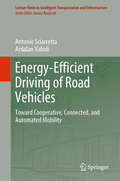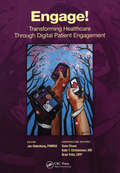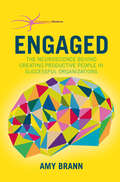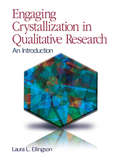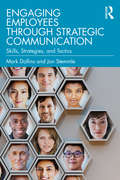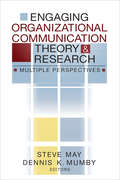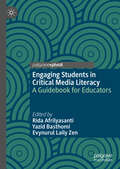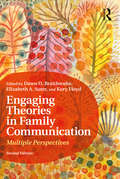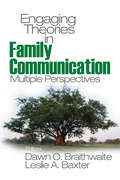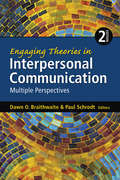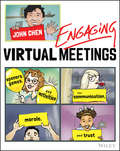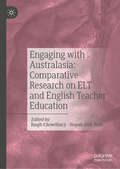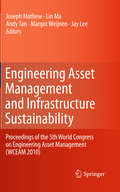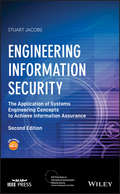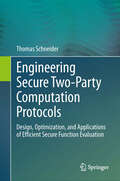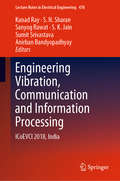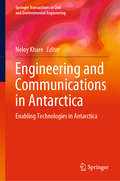- Table View
- List View
Energy-Efficient Algorithms and Protocols for Wireless Body Sensor Networks
by Jihong Yu Rongrong ZhangThis book provides a systematic treatment of the theoretical foundation and algorithmic tools necessary in the design of energy-efficient algorithms and protocols in wireless body sensor networks (WBSNs). These problems addressed in the book are of both fundamental and practical importance. Specifically, the book delivers a comprehensive treatment on the following problems ranging from theoretical modeling and analysis, to practical algorithm design and optimization: energy-efficient clustering-based leader election algorithms in WBSNs; MAC protocol for duty-cycling WBSNs with concurrent traffic; multi-channel broadcast algorithms in duty-cycling WBSNs; and energy-efficient sleep scheduling algorithms in WBSNs. Target readers of the book are researchers and advanced-level engineering students interested in acquiring in-depth knowledge on the topic and on WBSNs and their applications, both from theoretical and engineering perspective.
Energy-Efficient Driving of Road Vehicles: Toward Cooperative, Connected, and Automated Mobility (Lecture Notes in Intelligent Transportation and Infrastructure)
by Antonio Sciarretta Ardalan VahidiThis book elaborates the science and engineering basis for energy-efficient driving in conventional and autonomous cars. After covering the physics of energy-efficient motion in conventional, hybrid, and electric powertrains, the book chiefly focuses on the energy-saving potential of connected and automated vehicles. It reveals how being connected to other vehicles and the infrastructure enables the anticipation of upcoming driving-relevant factors, e.g. hills, curves, slow traffic, state of traffic signals, and movements of nearby vehicles. In turn, automation allows vehicles to adjust their motion more precisely in anticipation of upcoming events, and to save energy. Lastly, the energy-efficient motion of connected and automated vehicles could have a harmonizing effect on mixed traffic, leading to additional energy savings for neighboring vehicles. Building on classical methods of powertrain modeling, optimization, and optimal control, the book further develops the theory of energy-efficient driving. In addition, it presents numerous theoretical and applied case studies that highlight the real-world implications of the theory developed. The book is chiefly intended for undergraduate and graduate engineering students and industry practitioners with a background in mechanical, electrical, or automotive engineering, computer science or robotics.
Engage!: Transforming Healthcare Through Digital Patient Engagement (HIMSS Book Series)
by Jan Oldenburg Dave Chase Kate T. Christensen Brad TritleThis book explores the benefits of digital patient engagement, from the perspectives of physicians, providers, and others in the healthcare system, and discusses what is working well in this new, digitally-empowered collaborative environment. Chapters present the changing landscape of patient engagement, starting with the impact of new payment models and Meaningful Use requirements, and the effects of patient engagement on patient safety, quality and outcomes, effective communications, and self-service transactions. The book explores social media and mobile as tools, presents guidance on privacy and security challenges, and provides helpful advice on how providers can get started. Vignettes and 23 case studies showcase the impact of patient engagement from a wide variety of settings, from large providers to small practices, and traditional medical clinics to eTherapy practices.
Engaged Journalism
by Jake BatsellExplores the changing relationship between news producers and audiences and the methods journalists can use to secure the attention of news consumers.
Engaged Journalism: Connecting with Digitally Empowered News Audiences
by Jake BatsellExplores the changing relationship between news producers and audiences and the methods journalists can use to secure the attention of news consumers.
Engaged Journalism: Connecting with Digitally Empowered News Audiences (Columbia Journalism Review Books)
by Jake BatsellEngaged Journalism explores the changing relationship between news producers and audiences and the methods journalists can use to secure the attention of news consumers. Based on Jake Batsell's extensive experience and interaction with more than twenty innovative newsrooms, this book shows that, even as news organizations are losing their agenda-setting power, journalists can still thrive by connecting with audiences through online technology and personal interaction.Batsell conducts interviews with and observes more than two dozen traditional and startup newsrooms across the United States and the United Kingdom. Traveling to Seattle, London, New York City, and Kalamazoo, Michigan, among other locales, he attends newsroom meetings, combs through internal documents, and talks with loyal readers and online users to document the successes and failures of the industry's experiments with paywalls, subscriptions, nonprofit news, live events, and digital tools including social media, data-driven interactives, news games, and comment forums. He ultimately concludes that, for news providers to survive, they must constantly listen to, interact with, and fulfill the specific needs of their audiences, whose attention can no longer be taken for granted. Toward that end, Batsell proposes a set of best practices based on effective, sustainable journalistic engagement.
Engaged: The Neuroscience Behind Creating Productive People in Successful Organizations (The Neuroscience of Business)
by Amy BrannNeuroscience is revolutionizing our understanding of human psychology and behaviour. By showing how to apply this new understanding to how you recruit, manage, and develop your people, Brann is enabling you to deliver a step change in organizational performance and individual achievement.
Engaging Communication
by Cheri J. Simonds Stephen K. Hunt Brent K. SimondsEngaging Communication is a brief yet substantive guide to becoming a critical consumer and producer of information. With an emphasis on media- and information-literacy, Engaging Communication supports students in becoming more competent, confident, and ethical communicators through chapters focused on foundational communication principles, crafting constructing clear messages, responding and listening, and communicating persuasively.
Engaging Crystallization in Qualitative Research: An Introduction
by Laura L. EllingsonEngaging Crystallization in Qualitative Research, the first "how to" book to both explain and demonstrate crystallization methodology, offers a framework for blending grounded theory and other social scientific analyses with creative representations of data, such as narratives, poetry, and film. Author Laura L. Ellingson explores relevant epistemological questions that arise when crossing methodological boundaries, provides detailed steps for design and planning, offers guidelines for improving both social scientific and creative/artistic writing, and suggests strategies for targeting publication outlets for multigenre representations.
Engaging Employees through Strategic Communication: Skills, Strategies, and Tactics
by Mark Dollins Jon StemmleEngaging Employees through Strategic Communication provides a detailed overview of employee communication and its evolution as a tool to drive employee engagement and successful change management. Approaching the subject with the philosophy that internal audiences are essential to the success of any strategic communication plan and business strategy—particularly as they relate to driving change—Mark Dollins and Jon Stemmle give readers a working knowledge of employee communication strategies, skills, and tactics in ways that prepare students for careers in this rapidly expanding field. Providing the tools necessary to evaluate the impact of successful employee communication campaigns, they put theory and cutting-edge research into action with practical examples and case studies sourced from award-winning entries judged as best-in-class by the International Association of Business Communicators (IABC), the Public Relations Society of America (PRSA), PRWeek, and PRNews. The book is ideal for undergraduate and graduate students in internal, corporate, or employee communication courses and will be a useful reference for practitioners who want to understand how to carry out effective employee communication engagement and change-management campaigns.
Engaging Organizational Communication Theory and Research: Multiple Perspectives
by Steve May"This book offers a refreshing and engaging overview of the ways some research traditions in organizational communication have unfolded over time and continue to be connected to everyday, real events."—Patrice Buzzanell, Purdue University Engaging Organizational Communication Theory and Research: Multiple Perspectives is a book unlike any in the field. Each chapter is written by a prominent scholar who presents a theoretical perspective and discusses how he or she "engages" with it, personally examining what it means to study organizations. Rejecting the traditional model of a "reader," this volume demonstrates the intimate connections among theory, research, and personal experience. Significant theoretical perspectives such as post-positivism, social construction, rhetoric, critical theory, feminism, postmodernism, structuration theory, and globalization are discussed in terms of their history, assumptions, development, propositions, research, and applications. In addition to editors Steve May and Dennis K. Mumby, contributors include Brenda J. Allen, Karen Lee Ashcraft, George Cheney, Steven R. Corman, Stanley Deetz, Robert McPhee, Marshall Scott Poole, Cynthia Stohl, Bryan C. Taylor, and James R. Taylor. Key Features• An introduction that addresses the idea of engaged research.• Accessible and cutting edge accounts of important research traditions written by well-known leaders in the field.• Personal accounts of each scholar′s place in his or her field of study.• A conclusion that explores the future of organizational communication studies.• An extensive body of references on each perspective. Engaging Organizational Communication Theory and Research is an indispensable resource for anyone wishing to be familiar with current trends in the field of organizational communication. It is recommended as the main text for upper-level undergraduate and entry-level graduate courses in organizational communication theory. It is also an excellent supplementary text for related courses in departments of communication studies, business and management, sociology, and industrial relations.
Engaging Students in Critical Media Literacy: A Guidebook for Educators
by Yazid Basthomi Evynurul Laily Zen Rida AfrilyasantiThis edited book presents the integration of Critical Media Literacy (CML) principles into teaching English as a Foreign Language (EFL). This approach has its roots in content-based language learning, which aims to promote effective communication as the ultimate goal of language acquisition. This book highlights the profound influence of CML on educational methods, exploring the evolving concepts that support its integration and providing both theoretical perspectives and practical examples to illustrate its implementation. The book delineates methodologies for constructing and executing a CML integration framework in EFL lessons, offering various instructional strategies and reflective analyses and integrating the viewpoints of professionals, educators, and researchers. The book explores the complexities of CML, discussing the changing nature of language instruction in a world heavily influenced by media, and explores issues such as professional growth during educational restructuring, highlighting the significance of personal metamorphosis in attaining social equity. This book offers a concise yet thorough examination of CML integration in EFL settings, and it will be of interest to scholars specializing in education, media studies, and language instruction, as well as educators actively engaged in teaching, such as EFL teachers, curriculum developers, and educational policymakers.
Engaging Theories in Family Communication: Multiple Perspectives
by Dawn O. Braithwaite Kory Floyd Elizabeth A. SuterEngaging Theories in Family Communication, Second Edition delves deeply into the key theories in family communication, focusing on theories originating both within the communication discipline and in allied disciplines. Contributors write in their specific areas of expertise, resulting in an exceptional resource for scholars and students alike, who seek to understand theories spanning myriad topics, perspectives, and approaches. Designed for advanced undergraduate and graduate students studying family communication, this text is also relevant for scholars and students of personal relationships, interpersonal communication, and family studies. This second edition includes 16 new theories and an updated study of the state of family communication. Each chapter follows a common pattern for easy comparison between theories.
Engaging Theories in Family Communication: Multiple Perspectives
by Dawn O. BraithwaiteEngaging Theories in Family Communication: Multiple Perspectives covers uncharted territory in its field, as it is the first book on the market to deal exclusively with family communication theory. In this volume, editors Dawn O. Braithwaite and Leslie A. Baxter bring together a group of contributors that represent a veritable Who's Who in the family communication field. These scholars examine both classic and cutting-edge theories to guide family communication research in the coming years.
Engaging Theories in Interpersonal Communication: Multiple Perspectives
by Dawn O. Braithwaite Paul SchrodtWinner of the 2017 NCA Gerald R. Miller Book Award! Use and Understand Interpersonal Communication Theories Engaging Theories in Interpersonal Communication: Multiple Perspectives highlights key theories used to guide interpersonal communication research. The Second Edition features 30 theory chapters written by leading scholars in interpersonal communication, including new coverage of evolutionary theories, Problematic Integration Theory, supportive communication theories, Theory of Motivated Information Management, critical approaches to interpersonal communication, and Media Multiplexity Theory. Each theory chapter follows the same structure to help readers easily find and compare information across theories. An updated introductory chapter maps the history and the current state of interpersonal communication theory since publication of the first edition, based on comprehensive analysis of published scholarship. Presenting both classic and cutting-edge issues, the book organizes theories into three clusters—theories that are individually-centered; theories that are focused on discourse and interaction processes; and theories that examine how communication functions in personal relationships. All authors interweave abstract theoretical concepts with concrete examples in order to maximize readability and comprehension.
Engaging Theories in Interpersonal Communication: Multiple Perspectives
by Dawn O. Braithwaite Paul SchrodtWinner of the 2017 NCA Gerald R. Miller Book Award! Use and Understand Interpersonal Communication Theories Engaging Theories in Interpersonal Communication: Multiple Perspectives highlights key theories used to guide interpersonal communication research. The Second Edition features 30 theory chapters written by leading scholars in interpersonal communication, including new coverage of evolutionary theories, Problematic Integration Theory, supportive communication theories, Theory of Motivated Information Management, critical approaches to interpersonal communication, and Media Multiplexity Theory. Each theory chapter follows the same structure to help readers easily find and compare information across theories. An updated introductory chapter maps the history and the current state of interpersonal communication theory since publication of the first edition, based on comprehensive analysis of published scholarship. Presenting both classic and cutting-edge issues, the book organizes theories into three clusters—theories that are individually-centered; theories that are focused on discourse and interaction processes; and theories that examine how communication functions in personal relationships. All authors interweave abstract theoretical concepts with concrete examples in order to maximize readability and comprehension.
Engaging Virtual Meetings: Openers, Games, and Activities for Communication, Morale, and Trust
by John ChenBuild a cohesive and high-performing virtual team with this fantastic resource full of actionable advice and practical tips Engaging Virtual Meetings: Openers, Games, and Activities for Communication, Morale, and Trust offers concrete strategies and practical tips for bringing teams together across the digital divide. While many struggle to build teams in a virtual environment, accomplished author John Chen has found ways to create team cohesion, promote engagement, and increase virtual participation. In Engaging Virtual Meetings, he shares these methods with you, and also: Describes virtual tools for promoting effective teamwork, like the Participant Map Teaches you to optimize your teleconference setup for ideal audio and video Illustrates ways to apply these methods in any virtual environment, including Zoom, Microsoft Teams, and more Explores how to debrief your participants to improve your methods over time Perfect for anyone working in or with the increasingly prevalent virtual environment, Engaging Virtual Meetings is a great addition to the bookshelves of anyone interested in how to create and build engagement in team settings of all kinds.
Engaging with Australasia: Comparative Research on ELT and English Teacher Education
by Raqib Chowdhury Huynh Anh TuanThe book showcases collaborative intercultural research into English language teaching and English language teacher education across Australasia covering a broad range of topics from English education policies, curricular reform and practices, teacher professional development, and teacher and student identities. Together, the selected studies showcase how, in the shadow of the Pandemic, newer configurations in developing Asian and South-East Asian countries have complicated collaboration in teaching and research and how these contrast with practices in Australia. In particular, the studies highlight the need for both cultural and pedagogical adaptations in practitioners’ engagement with both policy and pedagogy. The book finds interested readership among emerging educators including graduate and doctoral researchers, as well as educators and policymakers.
Engaños digitales, víctimas reales: Historias de estafas por internet y hackeos en la Argentina
by Sebastián DavidovskyA partir de nueve casos reales ocurridos en la Argentina, Sebastián Davidovsky, periodista especializado en tecnología, explica delitos como grooming, hackeo, phishing y ransomware. Cada caso sirve para conocer cómo operan los criminales, cómo funcionan las estafas y cómo estar prevenidos para evitarlas. Usamos mail, apps, WhatsApp, home banking, archivamos, compramos, subimos fotos. Y no percibimos que, del otro lado, alguien acecha todos nuestros datos y la intimidad. A partir de nueve casos argentinos, Sebastián Davidovsky explica cómo operan los criminales a través del grooming, phishing, ransomware y otros delitos a los que todos estamos expuestos. Dice María O'Donnell que "a los que nos acercamos a la tecnología con ingenuidad, pero agradecidos por las oportunidades que ofrece, este libro resulta tan ameno como inquietante. No abruma con datos ni pretende convertirnos al nerdismo, pero con hechos reales -que reconstruye con precisión- alerta sobre riesgos poco evidentes. Las historias iluminan sobre qué pasa cuando las cosas funcionan mal en una red a la que entregamos más información de lo prudente. Sebastián nos saca de la zona de comodidad, porque estamos acostumbrados a disfrutar de las soluciones, pero no nos ponemos a pensar en qué nos quitan". Para Tomás Balmaceda, "por su volumen e impacto, es posible que estos nuevos delitos estén a punto de tenernos como víctimas (si no es que ya nos pasó). Con olfato para las grandes historias, rigor investigativo y un ritmo que no descansa, en este libro hay casos de la Argentina que nos obligan a repensar nuestra conducta digital. Además de entretener y crear conciencia, Sebastián brinda consejos para evitar ser víctimas de estos nuevos criminales, que no usan máscaras ni llevan ganzúas, sino que se esconden detrás de un usuario y una pantalla".
Engineering Asset Management and Infrastructure Sustainability
by Lin Ma Andy Tan Joseph Mathew Jay Lee Margot WeijnenEngineering Asset Management 2010 represents state-of-the art trends and developments in the emerging field of engineering asset management as presented at the Fifth World Congress on Engineering Asset Management (WCEAM). The proceedings of the WCEAM 2010 is an excellent reference for practitioners, researchers and students in the multidisciplinary field of asset management, covering topics such as: Asset condition monitoring and intelligent maintenanceAsset data warehousing, data mining and fusionAsset performance and level-of-service modelsDesign and life-cycle integrity of physical assetsEducation and training in asset managementEngineering standards in asset managementFault diagnosis and prognosticsFinancial analysis methods for physical assetsHuman dimensions in integrated asset managementInformation quality managementInformation systems and knowledge managementIntelligent sensors and devicesMaintenance strategies in asset managementOptimisation decisions in asset managementRisk management in asset managementStrategic asset managementSustainability in asset management
Engineering Electromagnetics
by Nathan IdaThis comprehensive two semester textbook, now in its 4th edition, continues to provide students with a thorough theoretical understanding of electromagnetic field relations while also providing numerous practical applications. The topics follow a tested pattern familiar to the previous edition, each with a brief, introductory chapter followed by a chapter with extensive treatment, 10 to 30 applications, examples and exercises, and problems and summaries. There is new emphasis on problems, examples and applications based on energy harvesting and renewable energy; additional information on sensing and actuation, new material on issues in energy, power, electronics, and measurements, and an emphasis on aspects of electromagnetics relevant to digital electronics and wireless communication. The author adds and revises problems to emphasize the use of tools such as Matlab; new advanced problems for higher level students; a discussion of symbolic and numerical integration; additional examples with each chapter; and new online material including experiments and review questions. The book is an undergraduate textbook at the upper division level, intended for required classes in electromagnetics. It is written in simple terms with all details of derivations included and all steps in solutions listed. It requires little beyond basic calculus and can be used for self-study.Features hundreds of examples and exercises, many new or revised for every topic in the book.Includes over 650 end-of-chapter problems, many of them new or revised, mostly based on applications or simplified applications.Includes a suite of online demonstration software including a computerized Smith Chart.
Engineering Information Security
by Stuart JacobsInformation security is the act of protecting information from unauthorized access, use, disclosure, disruption, modification, or destruction. This book discusses why information security is needed and how security problems can have widespread impacts. It covers the complete security lifecycle of products and services, starting with requirements and policy development and progressing through development, deployment, and operations, and concluding with decommissioning. Professionals in the sciences, engineering, and communications fields will turn to this resource to understand the many legal, technical, competitive, criminal and consumer forces and influences that are rapidly changing our information dependent society.If you're a professor and would like a copy of the solutions manual, please contact ieeepress@ieee.org.The material previously found on the CD can now be found on www.booksupport.wiley.com.
Engineering Secure Two-Party Computation Protocols
by Thomas SchneiderSecure two-party computation, called secure function evaluation (SFE), enables two mutually mistrusting parties, the client and server, to evaluate an arbitrary function on their respective private inputs while revealing nothing but the result. Originally the technique was considered to be too inefficient for practical privacy-preserving applications, but in recent years rapid speed-up in computers and communication networks, algorithmic improvements, automatic generation, and optimizations have enabled their application in many scenarios. The author offers an extensive overview of the most practical and efficient modern techniques used in the design and implementation of secure computation and related protocols. After an introduction that sets secure computation in its larger context of other privacy-enhancing technologies such as secure channels and trusted computing, he covers the basics of practically efficient secure function evaluation, circuit optimizations and constructions, hardware-assisted garbled circuit protocols, and the modular design of efficient SFE protocols. The goal of the author's research is to use algorithm engineering methods to engineer efficient secure protocols, both as a generic tool and for solving practical applications, and he achieves an excellent balance between the theory and applicability. The book is essential for researchers, students and practitioners in the area of applied cryptography and information security who aim to construct practical cryptographic protocols for privacy-preserving real-world applications.
Engineering Vibration, Communication and Information Processing: Icoevci 2018, India (Lecture Notes In Electrical Engineering #478)
by S. K. Jain Kanad Ray Sanyog Rawat Anirban Bandyopadhyay Sumit Srivastava S. N. SharanThis book discusses the revolution of cycles and rhythms that is expected to take place in different branches of science and engineering in the 21st century, with a focus on communication and information processing. It presents high-quality papers in vibration sciences, rhythms and oscillations, neurosciences, mathematical sciences, and communication. It includes major topics in engineering and structural mechanics, computer sciences, biophysics and biomathematics, as well as other related fields. Offering valuable insights, it also inspires researchers to work in these fields. The papers included in this book were presented at the 1st International Conference on Engineering Vibration, Communication and Information Processing (ICoEVCI-2018), India.
Engineering and Communications in Antarctica: Enabling Technologies in Antarctica (Springer Transactions in Civil and Environmental Engineering)
by Neloy KhareIndia launched its maiden scientific expedition to Antarctica way back in 1981 and ever since annual expeditions are launched to address thematic research in the contemporary areas of Antarctic Science and Engineering. The initial efforts and achievements of India are not only significant but are of historical importance.This book discusses a wide array of topics that have entered the mainstream of geotechnical and geo environmental engineering over the initial two and half decades of India’s presence in the icy continent ‘Antarctica’. At the same time, it highlights the lessons learnt in cryo-engineering technologies. It covers various articles on many aspects of environmental science and collates the overall achievements in the fascinating field of Antarctic engineering and environmental impact assessment. Accordingly, this book covers articles on wind energy by Ramesh et al., and engineering aspects in Antarctica by Rai. Similarly, Pathak has reviewed the engineering details of Dakshin Gangotri and Maitri. On the contrary, Sharma has provided an interesting history about the process of establishment of Dakshin Gangotri station. Similarly, communication aspects have been highlighted by Dhaka. Commercial polymers and their utility in cold region have been discussed by Dabholker et al. Besides, Tiwari and Khare have reviewed the environmental studies carried out during the initial 25 years in Antarctic research base ‘Maitri’. Similarly, Ramchandran and Sathe have studied the natural radioactivity in Antarctica while fire safety in Antarctica has been touched upon by Chatterjee. On the other hand, Veerbhadraiah and Jain have provided a status on environmental management services at Maitri station Additionally Tiwari has provided details on the new Indian Research Base ‘Bharti’ at Larsemann Hills region. It provides a one-stop reference for researchers and those working in industry and government.

